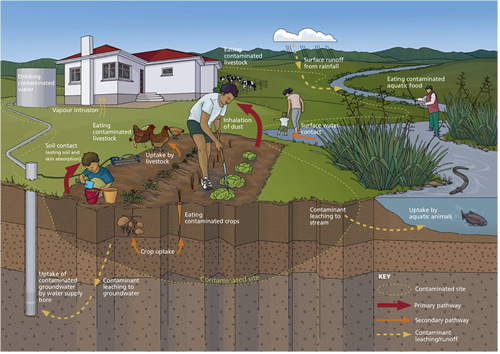Contaminated Land

The past use of chemicals (hazardous substances) in industry, agriculture and horticulture has left a legacy of soil contamination in New Zealand. This contamination has been mainly caused by past practices in which chemicals were used, stored and disposed of in a way that is not safe by today’s standards.
Land can become contaminated through this manufacture, use, storage and disposal of hazardous substances and while contamination is usually associated with industrial activities, the use of hazardous substances in agriculture can also cause contamination, as can residential activities and buildings.
Contaminated land is defined by the Ministry for the Environment as sites at which hazardous substances occur at concentrations above background levels and where assessment indicates it poses, or is likely to pose, an immediate or long-term risk to human health or the environment.
People can become exposed to contaminants in soil through contact with the soil, soil ingestion, eating produce grown on contaminated land and drinking contaminated ground or surface water. If a contaminant is volatile, people may also be exposed by inhalation. The health risk associated with contaminated soil will depend on the type of hazardous substance, the exposure route and the length of time a person is exposed.

The Ministry for the Environment provides leadership on land contamination across central and local government. Regional councils and territorial local authorities have functions under the Resource Management Act, Sections 30 and 31 respectively, for the day-to-day management of contaminated land.
Toi Te Ora Public Health works collaboratively with local authorities and other agencies to ensure the public health effects of contaminated land are identified and risk assessed, so that the hazards can be isolated, decreased or remedied.
Toi Te Ora also provides health information and advice on specific land contaminants, including lead, asbestos and other hazardous substances. Health advice can also be given to persons who believe that they may have been exposed to other soil based contaminants.
Resources
- Soil contaminants and health - Ministry of Health
- Arsenic and health - Ministry of Health
- National Environmental Standard for Assessing and Managing Contaminants in Soil to Protect Human Health
- National Environmental Standard for Assessing and Managing Contaminants in Soil to Protect Human Health: Information for landowners and developers
- Contaminated land management guidelines
- Hazardous Activities and Industries List (HAIL)
- Intractable Agricultural Chemicals in New Zealand
- Health and Environmental Guidelines for Selected Timber Treatment Chemicals
- Australian and New Zealand Guidelines for the Assessment and Management of Contaminated Sites





